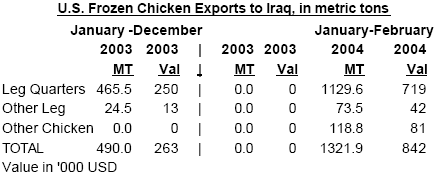



International Egg and Poultry Review
By the USDA's Agricultural Marketing Service - This is a weekly report looking at international developments concerning the poultry industry, this week looking at the EU's Export Subsidies.
Romania HRI Food Sector
Romania is the second largest market in east-central Europe after
Poland, with 21.7 million emerging consumers and a strategic position
on the Black Sea. Romania has one of the fastest growing economies
in Europe and the GDP growth expanded by an estimated 4.9 percent
in 2003. Foreign direct investment inflows continue the ascendant trend,
with an anticipated value of $1.5 billion for 2004. In 2002 more than half
of the Romanian population was living in cities 55.9%.
According with the Romanian Customs Directorate, imports of agrifood
products reached $1.7 billion in 2003, 40% higher than in 2002.
About 33% of total agri-food imports were sourced from the EU. The
value of U.S. exports to Romania was $93 million (5.5%), to some
extent lower than in 2002. The major imported products were poultry
meat, soybeans, cigarettes, raw tobacco, pork meat, fish, nuts.

Source: Mednet Research 2003
The main foreign suppliers of poultry are the United States, Brazil and Hungary. The most frequently used meats are chicken legs, poultry liver, and turkey meat. The United States (49%) and Brazil (29%) were major supply sources of poultry to Romania in 2003. The U.S. has competitive prices compared to local producers, especially for chicken leg quarters that are preferred by the Romanian consumers.
Source: USDA/FAS

Source: Dept of Commerce, U.S. Census Bureau

Source:Dept of Commerce, U.S. Census Bureau
EU Firm on Export Subsidies
The European Union is sticking by its position that it is only prepared to
eliminate export subsidies on products of export interest to developing
countries, despite growing pressure from other WTO members for a
commitment by mid-year to negotiate an end-date for the end of export
refunds on all products. The EU Commission’s director for international
affairs in agriculture, Mary Minch, insisted that the mandate for
the Doha Round of farm trade talks “doesn’t imply an end date for all
products. I don’t think that it’s a good idea to say when, if or how WTO
members could eliminate export subsidies at this stage,” Minch told
reporters during a week-long negotiating session in Geneva at the end
of March, marking the re-launch of the agriculture talks.
Source: International Egg Commission
Mexico will export poultry meat to Japan
The President of the National Farmers Confederation (CNC), Heladio
Ramirez, indicated that Mexico will export 3,000 MT of poultry meat to
Japan during 2004. Mr. Ramirez added that, with this new trade
agreement, it is urgent that the Mexican Government support producers
by investing in the agricultural sector in order to train them and to
increase the level of infrastructure. During a meeting with the President
of the Agricultural Committee of the Lower House, the need to take
advantage of the trade opportunities with Japan was discussed, given
that Mexico imports about 70 percent of its food products.
Source: La Jornada, 02/12/04
Negotiations to export poultry to the U.S. worked out
The President of the Poultry Producers Association, Cesar de Anda,
stated that the project to export valued-added poultry products and
powder eggs to the United States has been worked out and by July
Mexican producers can begin to export to that market. There have been
negotiations with U.S. poultry producers and by the end of April Mexico
expects that inspectors from the United States Department of Agriculture
will have certified Mexican poultry plants. Currently there are only three
plants authorized to export product to the United States; these are located
in the states of Yucatan, Sinaloa, and Jalisco. Poultry exports were
banned due the presence of Newcastle disease and salmonella, but
Sinaloa, Sonora and Jalisco are free of these diseases and would be
eligible to export value-added poultry products and processed eggs.
Source : Reforma 02/06/04
To view the full report, including tables please click here (PDF Format)
Source: USDA's Agricultural Marketing Service - 27th April 2004








